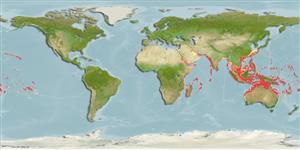>
Holocentriformes (Squirrelfishes, soldierfishes) >
Holocentridae (Squirrelfishes, soldierfishes) > Holocentrinae
Etymology: Sargocentron: Greek, sargos = sargus + Greek, kentron = sting (Ref. 45335).
More on author: Forsskål.
Environment: milieu / climate zone / depth range / distribution range
ນິເວດວິທະຍາ
ສັດທະເລ ກ່ຽວກັນຫີນ; ລະດັບຄວາມເລິກ 0 - 122 m (Ref. 9710). Tropical; 31°N - 38°S, 30°E - 124°W
Indo-Pacific: Red Sea and East Africa (Ref. 4201) to the Hawaiian and Ducie islands, north to southern Japan, south to Australia; throughout Micronesia.
ຂະໜາດ / ນ້ຳໜັກ / Age
Maturity: Lm ? range ? - ? cm
Max length : 51.0 cm FL ຕົວຜູ້/ບໍ່ມີເພດ; (Ref. 40637); common length : 35.0 cm TL ຕົວຜູ້/ບໍ່ມີເພດ; (Ref. 5450); ນ້ຳໜັກສູງສຸດທີ່ເຄຍຈັດພີມມາ: 2.6 kg (Ref. 40637); ອາຍຸສູງສຸດທີ່ເຄຍລາຍງານມາ: 7 ປີ (Ref. 126389)
ຄີ (ໜາມ)ແຂງຢູ່ຫຼັງປາ (ທັງໝົດ) : 11; ຄີຫຼັງຂອງປາ (ຄີອ່ອນ) (ທັງໝົດ) : 14 - 16; ຄີ(ໜາມ) ແຂງຢູ່ຄີກົ້ນປາ
ກຸ່ມປາກະດູກແຂງ
ຄວາມຖີ່ຂອງກຸ່ມຖ່າຍທອດພັນ
ປາທີ່ມີການເຄື່ອນຍ້າຍຈາກທະເລໄປຫານ້ຳຈືດ ແລະນ້ຳຈືດຫາທະເລ
ປາທີ່ມີການເຄື່ອນຍ້າຍຈາກທະເລແລະໄປໄຂ່ຢູ່ນ້ຳຈືດ
ຄີກົ້ນຂອງປາ
ສັດທີ່ມີກະດູກສັນຫັຼງ
ການຖ່າຍທອດທາງກຳມະພັນຈາກພໍ່ແມ່ຫາລູກ: 4; ຄີກົ້ນຂອງປາ: 9 - 10. Head and body red, scale edges silvery white; spinous dorsal crimson in color; other fins orange-yellow; vertically oblong crimson spot on preopercle behind eye (Ref. 4201). Five oblique scale rows on cheek; body depth 2.4-2.6 in SL; head length (HL) 2.55-2.85 in SL; lower jaw when closed slightly to moderately projecting; snout length 3.0-3.8 in HL larger than orbit diameter in adults; interorbital width 6.3-8.7 in HL; maxilla extending posteriorly to a vertical at front edge of the orbit; anterior end of nasal bone often with 2 close-set, short spines; medioposterior margin of nasal bone spineless; large nasal fossa spineless on margin; slight ridge of upper edge of suborbital bones weakly serrate; 2 subequal opercular spines; long preopercular spine, usually greater than orbit diameter in specimens at least 20 cm SL; 3rd or 4th dorsal spine longest, 1.7-2.3 in HL; 3rd anal spine 1.7-2.3 in HL (Ref. 27370).
A solitary species that inhabits a variety of reef zones from reef flats to lagoon and seaward reefs to a depth of at least 122 m and is fairly common in areas not subjected to heavy spear fishing. Found under ledges during the day (Ref. 9710). Benthopelagic (Ref. 58302). Largest species of squirrelfish and the highest-bodied Sargocentron (Ref. 37816). Juvenile inhabits shallow protected reefs. A nocturnal species that feeds on crabs, shrimps and small fishes. Spine of preopercle venomous. Largest squirrelfish (Ref. 48635). Minimum depth reported taken from Ref. 128797.
Life cycle and mating behavior
Maturities | ການສືບພັນ | Spawnings | Egg(s) | Fecundities | ຕົວອ່ອນ
Randall, J.E., 1998. Revision of the Indo-Pacific squirrelfishes (Beryciformes: Holocentridae: Holocentrinae) of the genus Sargocentron, with descriptions of four new species. Indo-Pac. Fish. (27):105 p. (Ref. 27370)
IUCN Red List Status (Ref. 130435)
Threat to humans
Reports of ciguatera poisoning (Ref. 2334)
Human uses
ການປະມົງ: ທີ່ເປັນການຄ້າໜ້ອຍ; ຕູ້ປາ: ບ່ອນວາງສະແດງສັນນ້ຳຂອງລັດ
ເຄື່ອງມື
Special reports
Download XML
ແຫຼ່ງອີນເຕີເນັດ
Estimates based on models
Preferred temperature (Ref.
123201): 24.4 - 29, mean 27.8 °C (based on 1488 cells).
Phylogenetic diversity index (Ref.
82804): PD
50 = 0.5000 [Uniqueness, from 0.5 = low to 2.0 = high].
Bayesian length-weight: a=0.01698 (0.01363 - 0.02116), b=2.98 (2.93 - 3.03), in cm total length, based on LWR estimates for this species (Ref.
93245).
ຊັ້ນເຂດຮ້ອນ (Ref.
69278): 3.6 ±0.4 se; based on diet studies.
Generation time: 4.8 ( na - na) years. Estimated as median ln(3)/K based on 1
growth studies.
ຄວາມຢືດຢຸ່ນ (Ref.
120179): ຂະໜາດກາງ, ປະຊາກອນຕຳ່ສຸດທີ່ໃຊ້ເວລາສອງເທົ່າ 1.4 - 4.4 ປີ (Preliminary K or Fecundity.).
Prior r = 0.59, 95% CL = 0.39 - 0.89, Based on 2 data-limited stock assessments.
Fishing Vulnerability (Ref.
59153): Moderate vulnerability (40 of 100).
Climate Vulnerability (Ref.
125649): Moderate to high vulnerability (54 of 100).
Nutrients (Ref.
124155): Calcium = 31.2 [13.0, 121.0] mg/100g; Iron = 0.443 [0.189, 1.251] mg/100g; Protein = 18.5 [17.3, 19.6] %; Omega3 = 0.14 [0.06, 0.30] g/100g; Selenium = 41.9 [25.8, 75.2] μg/100g; VitaminA = 95.3 [38.6, 226.8] μg/100g; Zinc = 1.33 [0.56, 2.50] mg/100g (wet weight); based on
nutrient studies.
